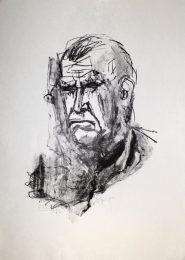Guest Curation – The Self Portrait
A curation of fine prints by Katherine Brimberry of Flatbed Press and Gallery.
Self portraits seem to occur in most artists’ practice at one point or another. Some artists return to it often leaving us a rich trail of their image throughout their lives. For others, it may be a rare subject matter. One’s self can be a convenient, always present subject matter. Inspiration may run from self reflection to analytical investigation of the image. Regardless of the inspiration and content, the self portrait allows us to see into the mind of the artist and the time frame that it was created.
Among the many prints represented through Printed Editions, there are some stunning examples of self portraiture.
We are familiar with the many self portraits that Rembrandt created during his lifetime. They chronicle him from young and successful to aging and struggling. A most interesting etching from early in his career is the tiny 4 1/2 x 3 3/4 inch image that shows Rembrandt with young wife Saskia. Rembrandt looks directly at the viewer in the foreground while Saskia looks on at him in the background. His demeanor seems confident, intense but bemused. He is well dressed and wearing a fashionable hat with a feather. Saskia looks at her husband in a more resigned and quiet manner. This etching’s composition is very similar to the painting “The Prodigal Son” completed about the same time, which also uses Rembrandt and Saskia as the models. They seem to be play-acting for this composition. Our imagination can fill in the scenario – Rembrandt calling for his wife to “sit” for him and the fun he has with their images quickly captured on the copper plate.
Otto Dix created numerous self portraits in paintings and prints during his life. In his later years, he created the lithograph Grosses Selbstbildnis (Large Self-portrait). The edition is small and printed on fine Japon paper. He has used a litho crayon to create the image which shows his aged face looking outside the viewer. His eyes which have been darkened lead us to think that he might be sightless. Dix uses few lines and straightforward use of the crayon to express his grim, perhaps stoic self at the age of 74.
I was excited to find two self portraits by Francesco Clemente listed in PrintedEditions. His Celtic Self-Portrait is especially intriguing. Knowing that Clemente likes to use paradoxes in his work, it was wonderful to find a great example of a self portrait that plays with this concept. His Celtic Self Portrait is an aquatint etching which shows two faces (one sleeping or dreaming) and the other fully awake (aware). A smoky spiral connects the two. Clemente has said: “Our appearance is a fiction. By duplicating a fiction, the person, with another fiction, the portrait, painting may expose how ephemeral our state is.” Evidence points to the face that Clemente created this print in Ireland while preparing for his 2003 exhibition at the Irish Museum of Modern Art. Clemente who likes to reach in his work for a metaphysical or spiritual reality, shows himself as Celtic in Ireland.
Kiki Smith often creates self portraits, and in this incredible one, instead of working from a reflected or remembered self image she was able to “map” her face and torso with the help of a special camera that is designed for map-making. Smith went about creating this two dimensional map of her face and torso as you might map the surface of the earth then spread it out to be flat and then transferred it to film. This photographic image was etched into a copper plate using a photogravure process combined with lithography to add additional color. It is interesting to note that the finished image is approximately life size in scale. Smith added drypoint additions in red to render more map-like details. An article worth reading about the process is here: https://beyondlikeness.omeka.net/exhibits/show/beyond-likeness/catalogue/smith-my-blue-lake
Although not titled as a self-portrait, Etchaedge is an image of the artist himself in the act of creating a suite of etchings. This etching, created at Flatbed Press by Trenton Doyle Hancock, records his experience during the making of his artists portfolio, “Bye and Bye: Nine Sad Etchings” in 2003. At the end of the week of intense work to make the etchings for the portfolio, Hancock decided to use the aquatint spit-bite test plate to draw this humorous, active self-portrait. I love how he drew his intensely focused self while drawing on a plate (above the belt) with the cartoon-like running legs (below the belt) showing his state of constant movement while developing the prints during five days! See the prints in “Bye and Bye – Nine Sad Etchings” in Flatbed’s Hancock collection here: https://flatbed-press.myshopify.com/products/bye-and-bye-nine-sad-etchings-9 6. Self Portrait by Luis Jimenez
Luis Jimenez’s Self Portrait remains one of the most powerful self portraits I have seen. Jimenez created this monumental self portrait using a soft-ground drawing technique with three plates. Jimenez, who was born in El Paso, Texas, has cultural roots in the Dias de los Muerte tradition and in this self portrait he superimposes the skull of that tradition over his own image. He did this print at about the same time that he experienced the loss of sight in one of his eyes… a small death in his own body. His self image records that loss as seen in how he drew the left eye. The over arching statement is that of a memento mori, a reminder that we will all die. “I was as you are, you will be as I am.” Jimenez’s use of self portrait is rare in the history of his practice. This moment of introspection is a landmark work in his career.





